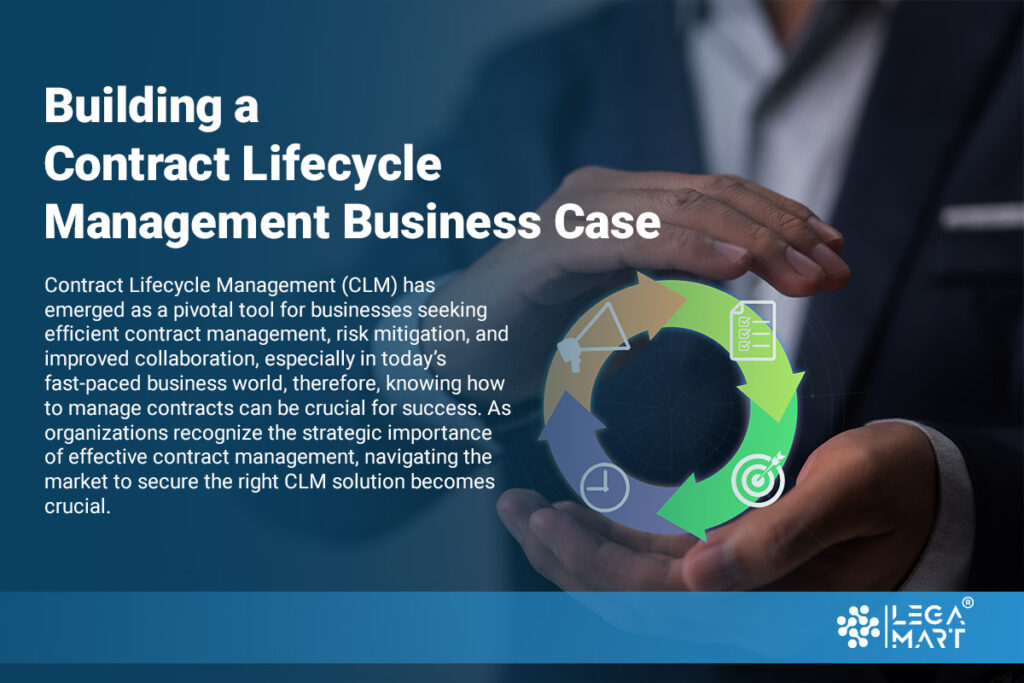Today, more than 60% of corporate legal departments still rely on manual processes to handle agreements. At the same time, three-quarters of global executives recognize that a contract lifecycle management (CLM) solution, enhanced by AI, can play a crucial role in any legal team. Besides, according to the latest market report from Credence Research, Inc., titled “Global Contract Lifecycle Management Market: Growth, Future Prospects, and Competitive Analysis, 2016 – 2028,” the global contract lifecycle management market has shown consistent growth. It is projected to experience a Compound Annual Growth Rate (CAGR) of 13.5% from 2023 to 2030. The market, valued at USD 1.2 Billion in 2022, is anticipated to reach USD 2.2 Billion by 2030.
Introduction
Contract Lifecycle Management (CLM) has emerged as a pivotal tool for businesses seeking efficient contract management, risk mitigation, and improved collaboration, especially in today’s fast-paced business world, therefore, knowing how to manage contracts can be crucial for success. As organizations recognize the strategic importance of effective contract management, navigating the market to secure the right CLM solution becomes crucial. Whether you’re negotiating a significant deal, reviewing an existing agreement, or trying to make your contract processes more efficient, it is essential to understand Contract Lifecycle Management (CLM). This article explores the key considerations in the journey of acquiring a strategic CLM solution, emphasizing the importance of building a compelling business case.
What Exactly is CLM?
Contract Lifecycle Management (CLM) is all about handling contracts from start to finish. It covers everything from creating and negotiating a contract to getting it approved, putting it into action, and keeping an eye on it until it’s closed. CLM gives businesses a structured way to deal with their contracts effectively and reduce the risks that come with managing contracts.
Understanding the CLM Landscape
The CLM market is diverse, offering a range of solutions with varying features, capabilities, and deployment models. Before diving into the market, organizations must assess their specific needs and objectives. Consider factors such as the volume of contracts, regulatory compliance requirements, integration capabilities with existing systems, and the level of automation desired. Understanding these elements sets the foundation for a tailored CLM strategy.
Why does Contract Lifecycle Management Matter?

Money and time savings
By using tools like CLM software, businesses can save time and cut down on administrative work. CLM software automates tasks related to contracts, like creating them, getting approvals, and reviewing them. This means less manual work and more time and money saved.
Smarter contract negotiations
CLM makes the contract process smoother, helping businesses negotiate terms and conditions more efficiently. It’s like a roadmap, making sure that the promises in a contract match up with what the business wants.
Clearer view of contracts
CLM puts all contracts in one place, making it easy to find and access important documents. It helps businesses see key contract details, like how well things are going, when it’s time to renew, and any possible risks.
Being able to analyze important contracts like this gives businesses an edge in making decisions and managing risks.
Less risk
When contracts are managed properly, there’s less chance of arguments, breaking the rules, or losing money. CLM lets businesses keep an eye on contract terms, deadlines, and promises, reducing the chances of breaking a contract and dealing with legal problems.
Building a Business Case
Understand your audience
Before making a case for contract lifecycle management software, identify who you are trying to convince, as this shapes your argument. Tailor your case to each stakeholder, focusing on what matters most to them. For example, if you’re a legal counsel aiming to persuade the General Counsel, emphasize time-saving benefits. Operations might value control over approvals, while HR could prioritize the signing experience. Consider involving stakeholders in vendor discussions to showcase firsthand how the software aligns with their needs and goals.
Begin by discussing the problem and not the solution
Instead of immediately expressing your desire for the software, outline the challenges faced with manual contract workflows. External stakeholders may not be aware of these issues, so it’s crucial to explain the problems clearly. Narrate the difficulties and highlight tangible downsides. Use real examples and figures to emphasize the severity of the problem and convey its urgency. Building trust and credibility is essential, and incorporating numbers adds weight to your persuasion.
Dive deeper into the issues associated with a manual contract workflow by examining them at various levels within the company.
At the top level, consider how inaction might impact the company’s overall strategy. For example, could increase contract risk jeopardize potential mergers or fundraising efforts? Are slow contract turnaround times hindering sales teams and impeding revenue targets?
On the financial side, analyze the consequences of not taking action. How much are legal document management costs currently inflated? Are you overpaying for underutilized licenses on existing tools? Is slow turnaround causing contract value leakage?
Examine the practical aspects on the ground, such as the existing contract lifecycle management process. Does it introduce unnecessary risks or waste significant time? Are current processes affecting job satisfaction and turnover rates? How much time is spent addressing repetitive queries from other departments about contracts?
Consider the broader impact of inefficient contract workflows beyond the legal team
Identify who else is affected, such as sales teams experiencing delays in legal review, finance departments dealing with missed contract renewals, or HR teams facing obstacles in hiring due to inefficient contract processes.
To gain stakeholder buy-in, emphasize the collective impact on the business rather than individual departments working in isolation. Highlight how investing in contract lifecycle management software benefits the entire organization.
Stress on the urgency of implementation
Clearly communicate the potential consequences of not acting within the desired timeframe. For instance, impending funding rounds may require a robust contract management system for due diligence, or a recent compliance issue due to ineffective contracting processes could have proven costly. Use compelling events to underscore the necessity and risks of delaying the implementation of contract lifecycle management software.
Convince them of the possibilities
Don’t just talk about the legal issues; paint a picture of what the legal function could achieve with CLM software. Highlight how it would streamline contract workflows, improve efficiency for other teams, and enable tasks currently impossible. Emphasize the significance of these improvements.
Share specific, measurable goals, like reducing contract creation time from 2 hours to 10 minutes, avoiding the need for additional legal hires, consolidating legal document systems from 5 to 1, speeding up approval for sales documents, and significantly decreasing the time your core legal team spends on contract management from 40% to 10%.
Connect the adoption to making money and cutting costs
You’ve put forth a proposal involving a significant investment, and now it’s crucial to illustrate the returns stakeholders can expect. The most effective approach is using ROI calculations, especially considering the high cost of employing legally trained staff and the direct impact contracts have on revenue, along with the financial risk associated with contract leakage.
When calculating the ROI for integrating contract lifecycle management software, consider factors like:
- Savings from time efficiency
- Increased revenue from quicker deal closures
- Reduction of financial risk through improved contract compliance
For a detailed calculation, take into account specific factors such as the number of contracts created monthly, employee hourly wages, time spent on manual contracts by legal, legal team size, contracts requiring approval, current contract turnaround time, signing rate, average contract value, monthly sales volume, number of salespeople, and past losses from missed renewals.
Conclusion
Securing a strategic CLM solution requires a thoughtful approach that goes beyond features and functionalities. Building a robust business case involves understanding organizational needs, quantifying benefits, and aligning the CLM initiative with strategic objectives. By navigating the CLM landscape with a clear vision and a compelling business case, organizations can embark on a journey towards efficient and effective contract lifecycle management.




